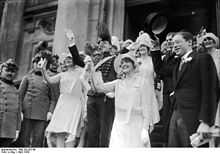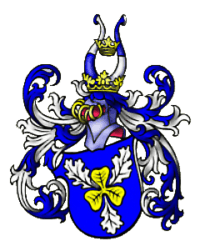Otto Christian Archibald von Bismarck
| Otto Christian Archibald von Bismarck | |||||
|---|---|---|---|---|---|
 The wedding of the Prince of Bismarck and Ann-Mari Tengbom, in the Berliner Dom, 1928. President Paul von Hindenburg, members of the cabinet and representatives of the Swedish embassy were present | |||||
| Prince of Bismarck | |||||
| Tenure | 18 September 1904 – 24 December 1975 | ||||
| Predecessor | Herbert von Bismarck | ||||
| Successor | Ferdinand von Bismarck | ||||
| Spouse | Ann-Mari Tengbom | ||||
| Issue |
Ferdinand von Bismarck Maximilian von Bismarck-Schönhausen Gunilla von Bismarck-Schönhausen Leopold von Bismarck-Schönhausen | ||||
| |||||
| House | House of Bismarck | ||||
| Father | Herbert von Bismarck | ||||
| Mother | Marguerite, Countess of Hoyos | ||||
| Born |
25 September 1897 Schönhausen, Brandenburg | ||||
| Died |
24 December 1975 (aged 78) Friedrichsruh, Schleswig-Holstein | ||||
| Burial | Friedrichsruh | ||||
| Styles of The Prince of Bismarck | |
|---|---|
 | |
| Reference style | His Serene Highness |
| Spoken style | Your Serene Highness |
| Alternative style | Sir |
Otto Christian Archibald, Prince von Bismarck (25 September 1897, Schönhausen, Brandenburg – 24 December 1975) was a German politician and diplomat, and the Prince of Bismarck from 1904 to his death.
He was the eldest of the three sons of Herbert von Bismarck, as well as the grandson of the German chancellor Otto von Bismarck and elder brother of Gottfried Graf von Bismarck-Schönhausen. A lawyer, he became the owner of the family estate in Schönhausen and joined the diplomatic service in 1927, serving in Stockholm (1927–28), London (1928–37), with the Foreign Ministry in Berlin (1937–40), as Envoy to Rome (Kingdom of Italy) (1940–43), and finally as head of the Italian section of the Foreign Ministry (1943–44).
In August 1942, Bismarck was directed to request that Italy turn over Jewish refugees in Italian-occupied Croatia for deportation to the East. He disclosed to the Italian Foreign Minister Count Ciano[1] that the goal was the "dispersion and elimination" of these Jews.[2]
He was a member of the DNVP (the conservative party) in the Weimar Republic, and served as a Member of Parliament from 1924 to 1928. In 1933 he joined the Nazi Party and in 1935 he became a member of the Anglo-German Fellowship. In the 1950s he considered becoming a member of the FDP (the liberal party), which offered him a nomination for Parliament, but eventually joined the conservative CDU instead. He served as a Member of Parliament for the constituency of Herzogtum Lauenburg (Duchy of Lauenburg, his grandfather held the title Duke of Lauenburg) from 1953 to 1965, and as a member of the foreign affairs committee. He was also a member of the Parliamentary Assembly of the Council of Europe, and served as its Vice President from 1959 to 1960 and from 1961 to 1966. He was also chairman of the Deutsche Parlamentarische Gesellschaft from 1957 to 1961. He received the Great Cross of Merit in 1965.
Bismarck married Ann-Mari Tengbom (1907–1999), a native of Sweden, daughter of Ivar Tengbom, on 18 April 1928, and they had six children, including the current head of the princely House of Bismarck, Ferdinand von Bismarck, and the philanthropist Gunilla von Bismarck. His grandson Carl-Eduard von Bismarck served as a Member of Parliament, representing the CDU for the constituency Herzogtum Lauenburg, from 2005 to 2007.
References
See also
| German nobility | ||
|---|---|---|
| Preceded by Herbert von Bismarck |
Prince of Bismarck 1904–1975 |
Succeeded by Ferdinand von Bismarck |
| Political offices | ||
| Preceded by |
Member of Parliament 1924–1928 |
Succeeded by |
| Preceded by |
Member of Parliament for the Duchy of Lauenburg 1953–1965 |
Succeeded by |
| Preceded by |
Chairman of the Deutsche Parlamentarische Gesellschaft 1957–1961 |
Succeeded by |
| Diplomatic posts | ||
| Preceded by |
German Envoy to the Kingdom of Italy 1940–1943 |
Succeeded by |
|